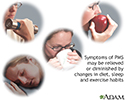Premenstrual syndrome
PMS; Premenstrual dysphoric disorder; PMDD
Premenstrual syndrome (PMS) refers to a wide range of symptoms. The symptoms start during the second half of the menstrual cycle (14 or more days after the first day of your last menstrual period). These usually go away 1 to 2 days after the menstrual period starts.
Causes
The exact cause of PMS is not known. Changes in brain hormone levels may play a role. However, this has not been proven. Women with PMS may also respond differently to these hormones.
PMS may be related to social, cultural, biological, and psychological factors.
Most women experience PMS symptoms during their childbearing years. PMS occurs more often in women:
- Between their late 20s and late 40s
- Who have had at least one child
-
With a personal or family history of
major depression
Major depression
Depression is feeling sad, blue, unhappy, or down in the dumps. Most people feel this way once in a while. Major depression is a mood disorder. It...
 ImageRead Article Now Book Mark Article
ImageRead Article Now Book Mark Article -
With a history of
postpartum depression
or an affective mood disorder
Postpartum depression
Postpartum depression is moderate to severe depression in a woman after she has given birth. It may occur soon after delivery or up to a year later....
Read Article Now Book Mark Article
The symptoms often get worse in a woman's late 30s and 40s as menopause approaches.
Symptoms
The most common symptoms of PMS include:
-
Bloating
or
feeling gassy
Bloating
Abdominal bloating is a condition in which the belly (abdomen) feels full and tight. Your belly may look swollen (distended).
 ImageRead Article Now Book Mark Article
ImageRead Article Now Book Mark ArticleFeeling gassy
Gas is air in the intestine that is passed through the rectum. Air that moves from the digestive tract through the mouth is called belching. Gas is ...
 ImageRead Article Now Book Mark Article
ImageRead Article Now Book Mark Article -
Breast tenderness
Breast tenderness
Premenstrual swelling and tenderness of both breasts occurs during the second half of the menstrual cycle.
 ImageRead Article Now Book Mark Article
ImageRead Article Now Book Mark Article - Clumsiness
-
Constipation
or
diarrhea
Constipation
Constipation in infants and children occurs when they have hard stools or have problems passing stools. A child may have pain while passing stools o...
 ImageRead Article Now Book Mark Article
ImageRead Article Now Book Mark Article - Food cravings
-
Headache
Headache
A headache is pain or discomfort in the head, scalp, or neck. Serious causes of headaches are rare. Most people with headaches can feel much better...
 ImageRead Article Now Book Mark Article
ImageRead Article Now Book Mark Article - Less tolerance for noises and lights
Other symptoms include:
- Confusion, trouble concentrating, or forgetfulness
-
Fatigue
and feeling slow or sluggish
Fatigue
Fatigue is a feeling of weariness, tiredness, or lack of energy.
Read Article Now Book Mark Article - Feelings of sadness or hopelessness
- Feelings of tension, anxiety, or edginess
- Irritable, hostile, or aggressive behavior, with outbursts of anger toward self or others
- Loss of sex drive (may increase in some women)
- Mood swings
- Poor judgment
- Poor self-image, feelings of guilt, or increased fears
- Sleep problems (sleeping too much or too little)
Exams and Tests
There are no specific signs or lab tests that can diagnose PMS. To rule out other possible causes of symptoms, it is important to have a:
- Complete medical history
- Physical exam (including pelvic exam)
A symptom calendar can help women identify the most troublesome symptoms. This also helps in confirming the diagnosis of PMS.
Treatment
Keep a daily diary or log for at least 3 months. Record the:
- Type of symptoms you have
- How severe they are
- How long they last
This record will help you and your health care provider find the best treatment.
A healthy lifestyle is the first step to managing PMS . For many women, lifestyle approaches are often enough to control symptoms. To manage PMS:
Lifestyle is the first step to managing...
PMS - self-care; Premenstrual dysphoric disorder - self-care

- Drink plenty of fluids like water or juice. Do not drink soft drinks, alcohol, or other beverages with caffeine. This will help reduce bloating, fluid retention, and other symptoms.
- Eat frequent, small meals. Do not go more than 3 hours between snacks. Avoid overeating.
- Eat a balanced diet. Include extra whole grains, vegetables, and fruit in your diet. Limit your intake of salt and sugar.
-
Your provider may recommend that you take nutritional supplements.
Vitamin B6
, calcium, and magnesium are commonly used. Tryptophan, which is found in dairy products, may also be helpful.
Vitamin B6
Vitamin B6 is a water-soluble vitamin. Water-soluble vitamins dissolve in water so the body cannot store them. Leftover amounts of the vitamin leav...
 ImageRead Article Now Book Mark Article
ImageRead Article Now Book Mark Article - Get regular aerobic exercise throughout the month. This helps in reducing the severity of PMS symptoms. Exercise more often and harder during the weeks when you have PMS.
- Try changing your nighttime sleep habits before taking drugs for insomnia.
Symptoms such as headache , backache, menstrual cramping, and breast tenderness may be treated with:
Headache
A headache is pain or discomfort in the head, scalp, or neck. Serious causes of headaches are rare. Most people with headaches can feel much better...

Menstrual cramping,
Painful menstrual periods are periods in which a woman has crampy lower abdominal pain, which can be sharp or aching and come and go. Back pain may ...

Breast tenderness
Breast pain is any discomfort or pain in the breast.

- Aspirin
- Ibuprofen
- Other NSAIDs
Birth control pills may decrease or increase PMS symptoms.
In severe cases, medicines to treat depression may be helpful. Antidepressants known as selective serotonin reuptake inhibitors (SSRIs) are often tried first. These have been shown to be very helpful. You may also want to seek the advice of a counselor or therapist.
Other medicines that you may use include:
- Anti-anxiety drugs for severe anxiety
- Diuretics, which may help with severe fluid retention, which causes bloating, breast tenderness, and weight gain
Outlook (Prognosis)
Most women who are treated for PMS symptoms get good relief.
PMS symptoms may become severe enough to prevent you from functioning normally.
The suicide rate in women with depression is much higher during the second half of the menstrual cycle. Mood disorders need to be diagnosed and treated.
When to Contact a Medical Professional
Make an appointment with your provider if:
- PMS does not go away with self-treatment
- Your symptoms are so severe that they limit your ability to function
- You feel like you want to hurt yourself or others
References
Alvero R. Premenstrual syndrome. In: Ferri FF, ed. Ferri's Clinical Advisor 2017 . Philadelphia, PA: Elsevier; 2017: 1031-1032.
Biggs WS, Demuth RH. Premenstrual syndrome and premenstrual dysphoric disorder. Am Fam Physician . 2011;84(8):918-924. PMID: 22010771. www.ncbi.nlm.nih.gov/pubmed/22010771 .
Marjoribanks J, Brown J, O'Brien PM, Wyatt K. Selective serotonin reuptake inhibitors for premenstrual syndrome. Cochrane Database Syst Rev . 2013(6). PMID: 23744611. www.ncbi.nlm.nih.gov/pubmed/23744611 .
-
Premenstrual bloating - illustration
Exercising to sweat out excess fluids and increasing your intake of high-fiber foods will help relieve premenstrual bloating.
Premenstrual bloating
illustration
-
Relieving PMS - illustration
The cause of premenstrual syndrome is not known but severe symptoms have been shown to be responsive to lifestyle changes. Getting exercise several times a week, eating a balanced diet, getting adequate sleep, and reducing or eliminating caffeine and alcohol are some of the changes most often recommended.
Relieving PMS
illustration
-
Premenstrual bloating - illustration
Exercising to sweat out excess fluids and increasing your intake of high-fiber foods will help relieve premenstrual bloating.
Premenstrual bloating
illustration
-
Relieving PMS - illustration
The cause of premenstrual syndrome is not known but severe symptoms have been shown to be responsive to lifestyle changes. Getting exercise several times a week, eating a balanced diet, getting adequate sleep, and reducing or eliminating caffeine and alcohol are some of the changes most often recommended.
Relieving PMS
illustration
-
Premenstrual syndrome
(In-Depth)
-
Premenstrual syndrome
(Alt. Medicine)
Review Date: 5/21/2016
Reviewed By: Linda J. Vorvick, MD, Medical Director and Director of Didactic Curriculum, MEDEX Northwest Division of Physician Assistant Studies, Department of Family Medicine, UW Medicine, School of Medicine, University of Washington, Seattle, WA. Also reviewed by David Zieve, MD, MHA, Isla Ogilvie, PhD, and the A.D.A.M. Editorial team.



